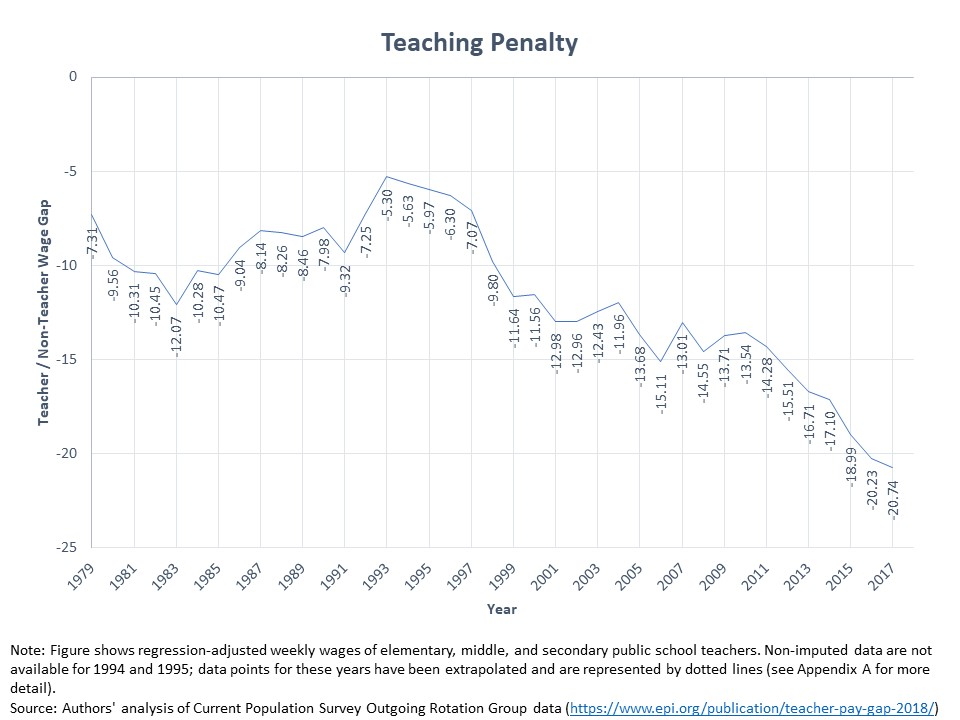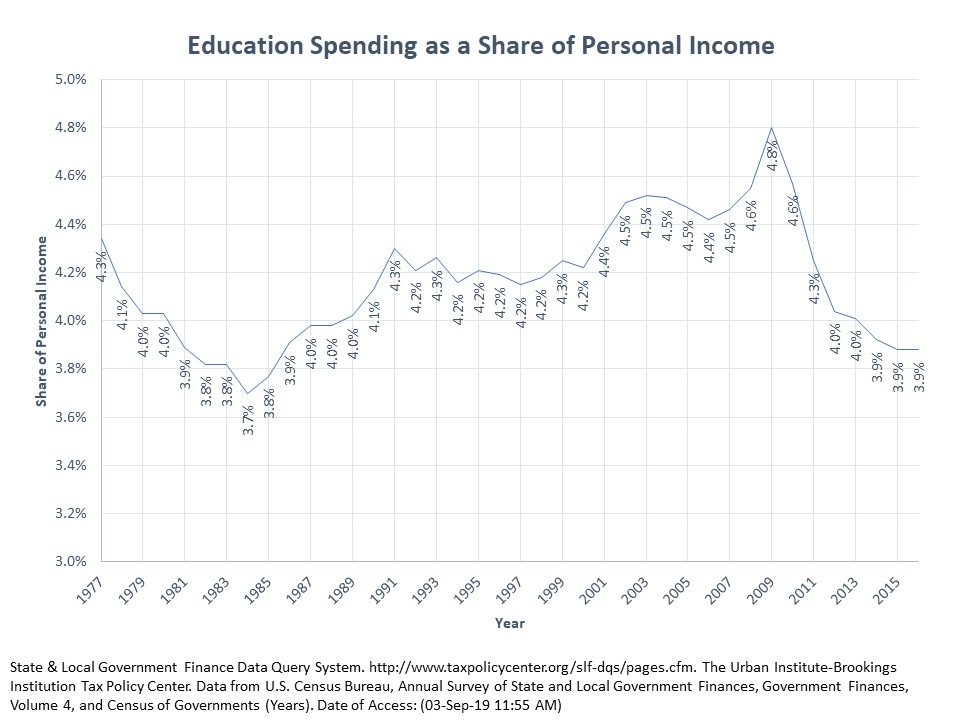School Finance 101: On Teachers & Teacher Bashing
https://www.cbsnews.com/news/how-we-have-failed-our-teachers/
Certainly, lagging compensation is a major issue. Teacher wages have plummeted over time with respect to similarly educated (weekly) non-teacher wages.

The share of economic capacity spent on K12 schooling over time has dropped:

And NO! spending hasn’t increased dramatically, nor have staffing ratios:


At least not for nearly 20 years! This, despite increased demands on schools!
Further, states that put up the least effort, tend to have the crappiest wages:

Then there’s this other issue of the rhetoric about “bad teachers,” and their evil “unions.” That’s actually softened in recent years. But this rhetoric has likely also had some influence on young people’s desire to enter the teaching profession. I mean seriously, you’ve got popular international outlets like The Economist calling teachers and their unions the greatest impediment to closing income gaps ever and anywhere (more than any Wall Street financier) and Wall Street financiers taking that ball and running with it, comparing teachers and their unions to the KKK and Governor George Wallace.
Then, you have more subtly manipulative efforts to pit young, incoming teachers against their elders, to distract teachers and the general public from the problems so evident in the graphs above. Below is a short section I removed from my book due largely to space constraints:
Who is to Blame?
If our schools really are so bad and if we really spend so much to achieve such deplorable outcomes, then where can we point our finger of blame? And how can we fix these systemic failures? An emergent theme during the “new normal” era was that U.S. schools have a “bad teacher” problem, and the best way to solve that problem was to establish methods and metrics to systematically identify and dismiss all of the bad teachers, while taking the money saved to pay good teachers more. The barrier, however, to achieving these reforms was the teachers unions, who were characterized as thwarting the removal of bad teachers at every turn.
In March of 2010, Newsweek put it right out there in an article titled “We Must Fire Bad Teachers.” (H/T to Dana Goldstein who addresses this article in her book Teacher Wars). The set-up in the Newsweek piece is familiar:
“The relative decline of American education at the elementary- and high-school levels has long been a national embarrassment as well as a threat to the nation’s future. Once upon a time, American students tested better than any other students in the world. Now, ranked against European schoolchildren, America does about as well as Lithuania, behind at least 10 other nations.”[i]
The Newsweek piece comes to the conclusion that “Nothing, then, is more important than hiring good teachers and firing bad ones.” However, one thing stands in the way. As explained in Newsweek: “At the same time, the teachers’ unions have become more and more powerful. In most states, after two or three years, teachers are given lifetime tenure. It is almost impossible to fire them.”
These arguments have continued to morph in recent years, and presently involve two main assertions:
- Bad teachers and protectionist unions are the reason for America’s general decline in education quality, coupled with burgeoning expenses associated with experienced-based pay and outdated pension systems.
- Bad teachers and their unions are also the reason for inequality of teacher quality between rich and poor schools because of seniority protections and tenure.
That is, teachers and their unions are the primary drag on overall quality and a primary cause of inequality of educational opportunity. These two assertions form the basis of a recent spate of lawsuits which claim that teacher seniority protections and tenure laws – not funding levels or disparities or any other factor for that matter – are the primary cause of inequitable and inadequate schools for low income and minority children, in violation of education articles of state constitutions (in California, New Jersey and New York).[ii] And these claims are built on the assertion that competitive wages and equitable wages across schools and districts have absolutely nothing to do with the quality of the teacher workforce or the distribution of quality teachers.
Again, it may seem that I’m exaggerating claims of teacher and union responsibility. But extreme examples are not difficult to find in relatively mainstream sources (like Newsweek). An article in the Economist proclaimed in October of 2012:
School reform and introducing choice is crucial: no Wall Street financier has done as much damage to American social mobility as the teachers’ unions have.[iii]
(note: Really? are you F……. kidding me?)
Similar claims were reiterated in the Economist more recently:
Many schools are in the grip of one of the most anti-meritocratic forces in America: the teachers’ unions, which resist any hint that good teaching should be rewarded or bad teachers fired.[iv]
If it wasn’t bad enough to be compared disfavorably to Wall Street financiers, a Wall Street financier has more recently compared teachers’ unions disfavorably to the KKK. Dan Loeb, New York hedge fund manager, charter school supporter and Chairman of the Board of Success Academy charter schools[v] has made even more bold claims and suspect comparisons of teacher’s unions’ role in promoting inequality:
If you truly believe that education is the dividing line (and I concur) then you must recognize and take up the fight against the teachers union, the biggest single force standing in the way of quality education and an organization that has done more to perpetuate poverty and discrimination against people of color than the KKK.[vi]
(note: this is almost as good as if the Sackler’s were to blame teachers for getting kids addicted to drugs)
Finally, teacher’s pensions have come under fire in a carefully articulated assault financed in part by Laura and John Arnold of Enron notoriety. [vii] Among other fiscal malfeasance, Enron is known for channeling their own employees benefits (>60%) into Enron stock as the company collapsed and while executives unloaded their own shares. A core assertion of the attack on teacher pensions is that the obligation to fund pensions for existing and retired employees is unnecessarily diverting money from classrooms. As described in one recent report, teacher pensions are gobbling up classroom resources like PacMan.[viii] That is, pension obligations, not tax cuts or reduced state funding are the major cause of tight classroom dollars and lagging teacher wages.[ix] A recent article in The Atlantic noted:
Without the $6,800 in “pension debt,” Aldeman contends public-school systems could spend that money on teacher salaries or other instructional material to improve student outcomes.[x]
Other organizations, including the Thomas B. Fordham Institute have jumped on the pensions-are-the-problem bandwagon.[xi] It’s a rather easy political sell to convince the public that cash-strapped states should be able to recapture pension funds hoarded by spoiled, self-indulgent retirees lounging pool-side in Del Boca Vista, and put those funds back into classrooms for the benefit of children! Some have even suggested that current school spending shortfalls could be remedied by municipal bankruptcy and pension fund dissolution, allowing cash strapped cities to redirect contractually obligated pension funds to classrooms.[xii] Of course, it’s unlikely that any pension funds would ever make it to classrooms while other creditors wait in the wings for their share of the spoils to be distributed in bankruptcy court.
One might cynically view these arguments as an effort to pit young teachers against old by telling them that the main reason their salaries are low is because old and retired teachers are collecting gold-plated pensions, not because of tax cuts or aid reductions. A similar tactic was exposed about a decade ago, when Overstock.com CEO Patrick Byrne established an organization named “1st Class Education” and bankrolled Arizona-based lobbyist Tim Mooney to wine-and-dine state legislators to encourage them to pass the seemingly innocuous 65% solution. The proposal was that states require school districts to prove they allocate 65% of funding to “instruction.” The proposal was sold to policymakers and pitched to the public as a way to increase classroom spending without increasing overall spending or taxes. 65% was chosen as a somewhat arbitrary figure slightly greater than the existing national average, based on federal data sources. The Austin American Statesmen (Texas) however, got ahold of an internal memo from Tim Mooney (the Arizona lobbyist) to Texas republican legislators outlining the real purpose of the proposal, which included as its first bullet point: “Splitting of the Education Union. The 1st Class Education proposal pits administrators and teachers at odds with one another.”[xiii]
[i] Thomas, Evan. Why we must fire bad Teachers. Newsweek. March 5, 2010 http://www.newsweek.com/why-we-must-fire-bad-teachers-69467
[ii] Vergara v. State of California, 246 Cal. App. 4th 619, 202 Cal. Rptr. 3d 262 (Ct. App. 2016).
[iii] True Progressivism. The Economist. Oct 13, 2012. http://www.economist.com/node/21564556
[iv]America’s New Aristocracy. The Economist. Jan 22, 2015 http://www.economist.com/news/leaders/21640331-importance-intellectual-capital-grows-privilege-has-become-increasingly
[v] Shapiro, Eliza. Loeb will remain chair of Success Academy board following racial remark. Politico. Aug. 11, 2017. http://www.politico.com/states/new-york/city-hall/story/2017/08/11/loeb-will-remain-chair-of-success-academys-board-113906
[vi] Davis, Owen. Dan Loeb sure loves comparing public servants to the KKK, Part Two. Deal Breaker. Aug. 14, 2017. http://dealbreaker.com/2017/08/dan-loeb-sure-loves-comparing-public-servants-to-the-kkk/
Others have recently compared unions to segregationist Alabama Governor George Wallace:
Mezzacappa, Dale, Wolfman-Arent, Avi. Well-regulated charters improve education for low-income students, author says. The Notebook. Sept. 8, 2017
[vii] For information on funders and founders of the teacher pension project, see: https://www.teacherpensions.org/about-us
see:
Weinberg, Ari. The Post-Enron 401(k) Forbes. Oct. 20, 2003 https://www.forbes.com/2003/10/20/cx_aw_1020retirement.html
[viii]Aldeman, Chad. What Do Pac-Man and Pensions Have in Common? TeacherPensions.org May 2016. https://www.teacherpensions.org/resource/what-do-pac-man-and-pensions-have-common
[ix] Aldeman, Chad. What Do Pac-Man and Pensions Have in Common? TeacherPensions.org May 2016. https://www.teacherpensions.org/resource/what-do-pac-man-and-pensions-have-common
[x]Zinshteyn, Mikhail. What teachers lose to pension debt. The Atlantic. May 13, 2016https://www.theatlantic.com/education/archive/2016/05/what-teachers-lose-to-pension-debt/482673/
[xi]Zeehandelaar, Dara, Winkler, Amber M. The Big Squeeze: Retirement Costs and School District Budgets. Thomas B. Fordham Institute. June 2013. http://edexcellencemedia.net/publications/2013/20130606-The-Big-Squeeze-Retirement-Costs-and-School-District-Budgets/20130606-the-big-squeeze-retirement-costs-and-school-district-budgets-FINAL.pdf
[xii]Harris, Bracey. EdBuild CEO: What you need to know. Clarion Ledger. Oct 12, 2016http://www.clarionledger.com/story/news/2016/10/12/edbuild-ceo-there-no-ulterior-motive/91938470/
See also: https://www.youtube.com/watch?v=3ylURYg0wuI
[xiii] Baker, Bruce D., and Douglas R. Elmer. “The politics of off-the-shelf school finance reform.” Educational Policy 23, no. 1 (2009): 66-105.
This blog post has been shared by permission from the author.
Readers wishing to comment on the content are encouraged to do so via the link to the original post.
Find the original post here:
The views expressed by the blogger are not necessarily those of NEPC.
